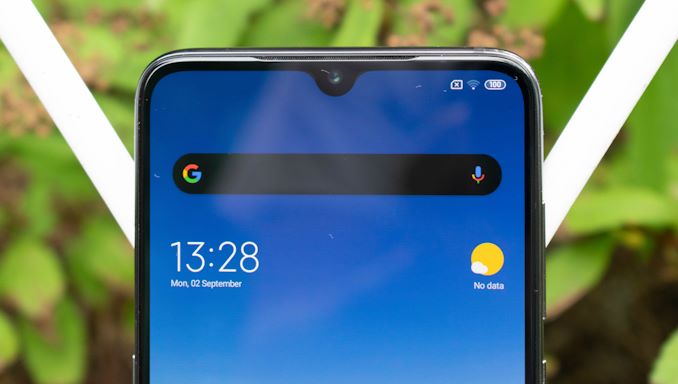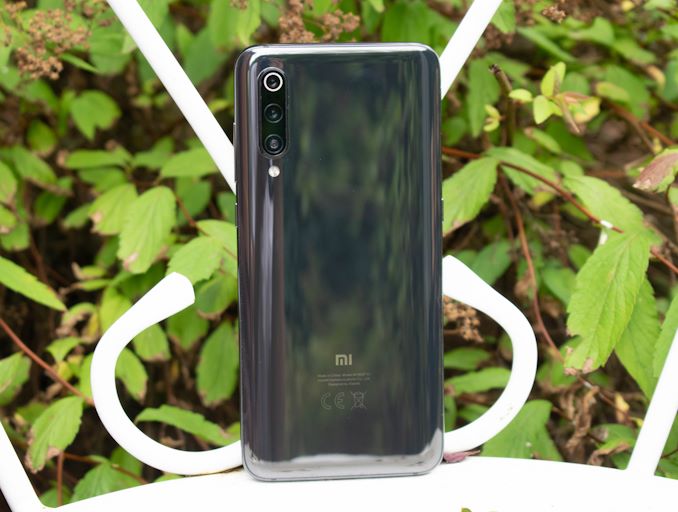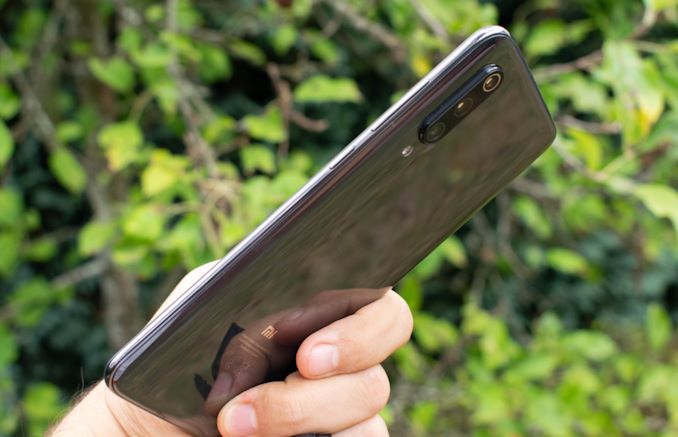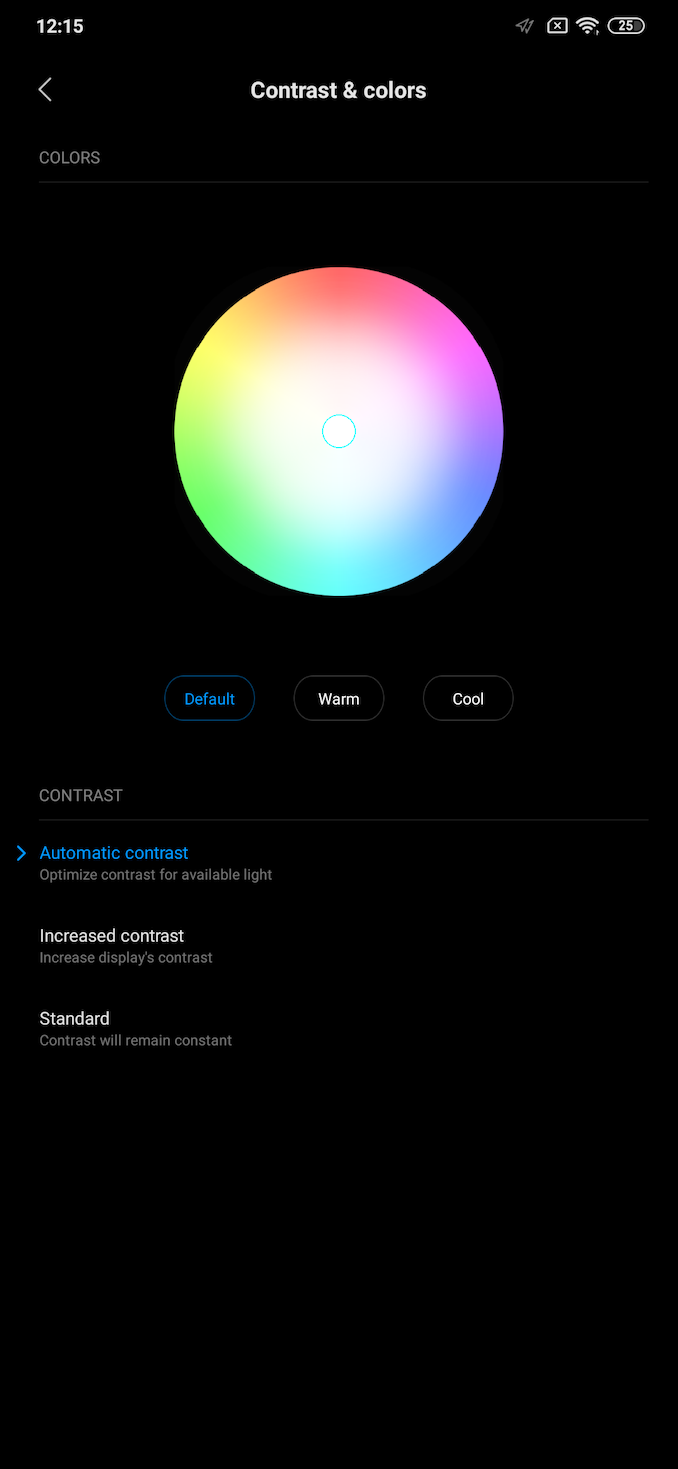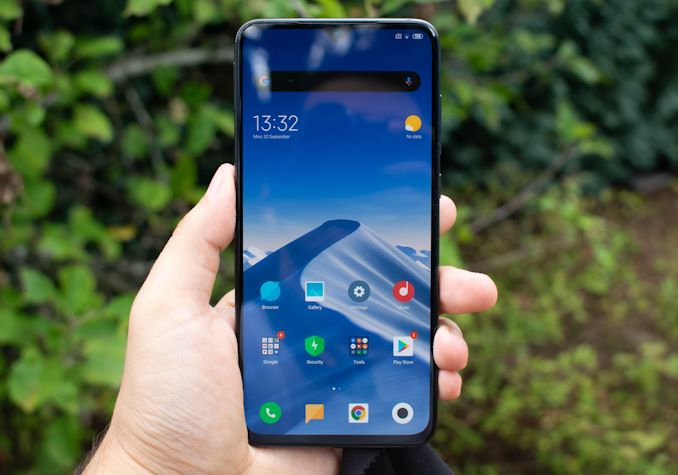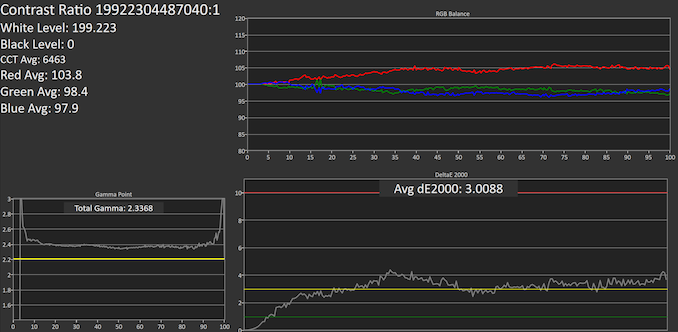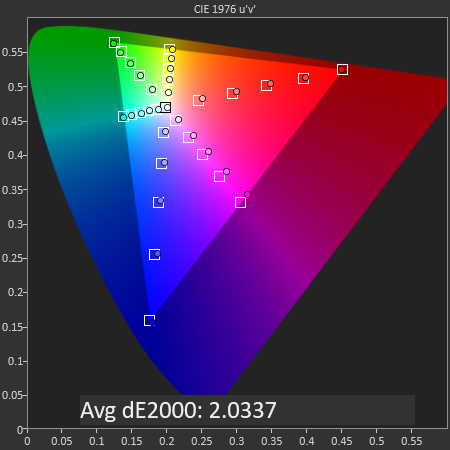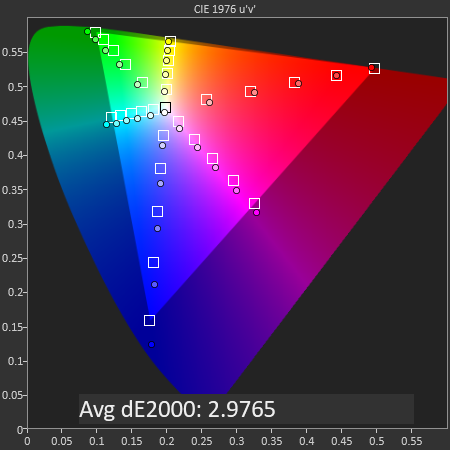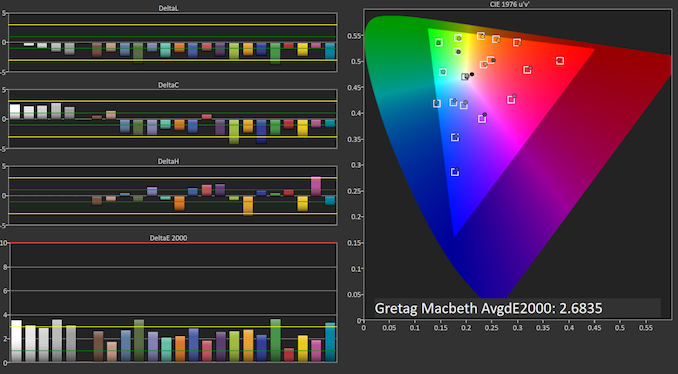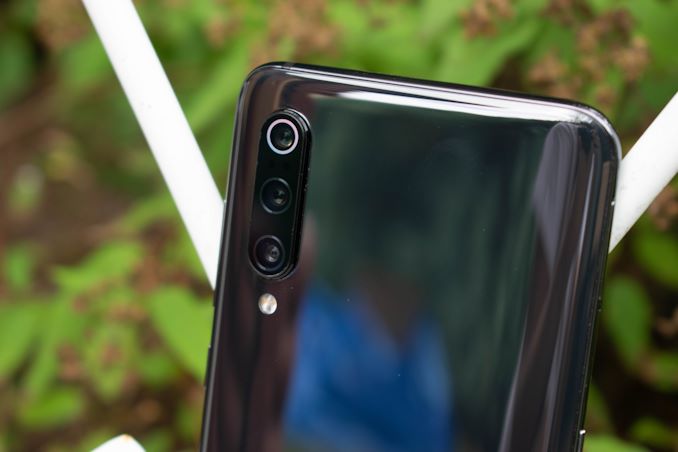
Original Link: https://www.anandtech.com/show/14714/the-xiaomi-mi9-review-flagship-perf-midrange-price
The Xiaomi Mi9 Review: Flagship Performance At a Mid-Range Price
by Andrei Frumusanu on September 13, 2019 9:00 AM EST- Posted in
- Smartphones
- Mobile
- Xiaomi
- Snapdragon 855
- Xiaomi Mi9
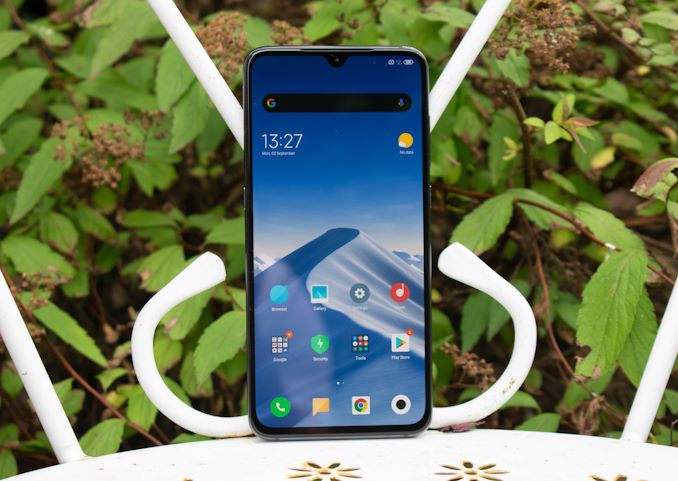
We’re edging towards to latter half of 2019 and the next and last upcoming wave of device releases, however among the many device releases of the year one device we missed to review was the new Xiaomi Mi9. The phone was amongst the earliest releases of the year, being actually representing one of the first Snapdragon 855 devices announced back in February.
Xiaomi’s always been an interesting vendor that stood out alongside Huawei as one of the bigger Chinese vendors that have a larger presence in the west. Particularly last year and especially this year Xiaomi has made a lot of progress in terms of their push in European markets by officially releasing and offering their flagship devices in different market. The Mi9, as opposed to past iterations, thus no longer represents being a special case or import device, but rather a simple official Amazon purchase.
Today the Mi9 can be had for even less than its original 445€ launch price, being available for less than 400€, whilst still offering flagship performance, a triple camera setup, a great screen, all in a compact and attractive package. We’ll go over the device and exactly investigate how Xiaomi is able to offer such hardware at a low price, if there’s compromises and where they lie.
| Xiaomi Mi9 | ||||
| Xiaomi Mi9 | ||||
| SoC | Qualcomm Snapdragon 855 1x Kryo 485 (Cortex-A76) @ 2.84GHz 3x Kryo 485 (Cortex-A76) @ 2.42GHz 4x Kryo 485 (Cortex-A55) @ 1.80GHz Adreno 640 @ 585MHz |
|||
| DRAM | 6GB LPDDR4X | |||
| Display | 6.39" AMOLED 2340 x 1080 (19.5:9) |
|||
| Size | Height | 157.5 mm | ||
| Width | 74.67 mm | |||
| Depth | 7.61 mm | |||
| Weight | 173 grams | |||
| Battery Capacity | 3300mAh 18W charger included / 27W support |
|||
| Wireless Charging | Qi | |||
| Rear Cameras | ||||
| Main | 48MP IMX586 0.8µm pixel w/PDAF f/1.8 |
|||
| Telephoto | 12MP IMX481 1.0µm f/2.2 45° 2x zoom |
|||
| Wide | 16MP S5K3M5 1.0µm f/2.2 117° |
|||
| Extra | - | |||
| Front Camera | 20MP 0.9µm f/2.0 |
|||
| Storage | 64/128GB UFS 2.1 | |||
| I/O | USB-C no 3.5mm headphone jack |
|||
| Wireless (local) | 802.11ac Wave 2 Wi-Fi Bluetooth 5.0 LE + NFC |
|||
| IP Rating | none | |||
| Other Features | In-screen optical fingerprint sensor | |||
| Dual-SIM | 1x nanoSIM + microSD or 2x nanoSIM |
|||
| Launch / Street Price | 64GB: 449€ / ~400€ | |||
First off, hardware wise, the Mi9 is very much a flagship device in terms of its components. It’s powered by the Snapdragon 855 like many other flagships this year, representing an excellent base platform for the phone to build on.
Xiaomi bundles the SoC with 6GB of DRAM in the global models, and comes with either 64GB or 128GB of UFS 2.1 storage. Unlike many other vendors to price the higher storage tier with significant mark-up, the 128GB variant can currently be had for only 25€ more – with some listing only even being 3€ more than the 64GB variant, a great contrast to what we see from other high-end vendors out there today.
The Mi9’s display is powered by a 6.39” AMOLED screen with a resolution of 2340 x 1080. While personally I would have liked a 1440p screen, the majority of users will have absolutely no issue with the screen’s sharpness. The display is an edge-to-edge design with minimal bezels on all sides, and is characterised by having a teardrop notch at the top housing the front camera. This style of notch is common and is probably the least controversial of all implementations we’ve seen over the last 2 years.
The device’s back is a typical curved back glossy glass design with all its positives and negatives. The negatives being again that this is quite the fingerprint magnet, however Xiaomi’s ergonomics on the phone are very much fantastic and exemplary.
We find a vertical side located camera setup with triple cameras, including a regular wide-angle, zoom and ultra-wide-angle modules. The main sensor is again the common IMX586 48MP sensor that we’ve seen with essentially almost every vendor out there this year and is paired with an f/1.8 lens. The telephoto module has a 12MP IMX481 sensor with f/2.2 lens, and finally the wide-angle is an S5K3M5 16MP sensor with a f/2.2 lens with a 117° viewing angle. The noticeable feature that is lacking on all the modules here is any kind of OIS – most likely a cost-cutting measure. The lack of OIS might have also allowed Xiaomi to make the camera housing relatively more narrow and smaller than what one is accustomed to from other phones in recent years.
As mentioned, the device’s ergonomics are quite excellent and I have to say they’re among the best of device I’ve held this year. Although the phone of a larger form-factor with 6.39” screen and a device width of 74.67mm, the phone actually feels a lot smaller thanks to the very narrow and rounded frame. Even at the centre of the phone it’s only 7.61mm thick. The only compromise I see Xiaomi as having made is the relatively smaller 3300mAh battery, which competitively is a few hundred mAh below of other options in the market this year. The bonus here is that Xiaomi actually offers wireless charging on the Mi9, making it a rare feature amongst devices in this price range and definitely a bonus.
At the bottom of the phone we find the speaker grill on the right side, and symmetrical hole-cut-outs on the left side which house the bottom microphone. There’s no headphone jack here naturally – Xiaomi was amongst the first Android vendors to drop it a few years ago – still something I found unfortunate. The phone comes with a USB-C to 3.5mm adapter, which is at least more than what other vendors like OnePlus managed to offer this year. Another audio compromise on the Mi9 is that earpiece grill seems quite big and capable, it’s not being used for stereo playback, instead relying on the bottom firing speaker primarily.
On the left side of the phone we find the dual nanoSIM tray, and the assistant button below it. Xiaomi uses the Google assistant here and it works very well. The right side of the phone has your usual volume rocket button as well as power buttons. The phone also has an optical under-screen fingerprint sensor that in my experience worked quite flawlessly – it was maybe just a little slower than the implementations from OnePlus or Huawei, but it still seemed to remain faster than the ultrasonic implementation from Samsung.
Overall design wise I’m a big fan of the Mi9. It’s just such an ergonomic and no-nonsense device that I found it a rather fresh breath of air amongst other designs this year. There are some clear compromises for the phone – such as battery size, lack of IP rating or the single mono speaker, however these seem to be compromises one can live with given the price of the device.
This leads me to the question as to how Xiaomi is able to actually achieve such pricing – the company in its home market of China notably thrives on razor thing hardware margins by making profits off of their e-commerce services, but how does this play out in Europe? One way Xiaomi seems to making additional money is through ads integrated in the OS – although I love the MIUI interface and it’s an overall very clean experience, Xiaomi does show ads in instances such as when after installing application, referring to other apps such as in my experience Booking.com. This really didn’t bother me too much as it’s only ever displayed it after installing applications, but it’s something that needs mention.
System Performance
Following our Snapdragon 855 device overview, we should be relatively familiar with how the Xiaomi Mi9 performs. The chipset is by now a very well known component and various devices with the silicon will only ever differ by the software stack implementation by the vendor.
In Xiaomi’s case in the Mi9, I didn’t see anything particularly standing out for the phone, performing quite well but also not particularly distinguishing itself as being among the best nor worst performers amongst its Snapdragon 855 siblings.
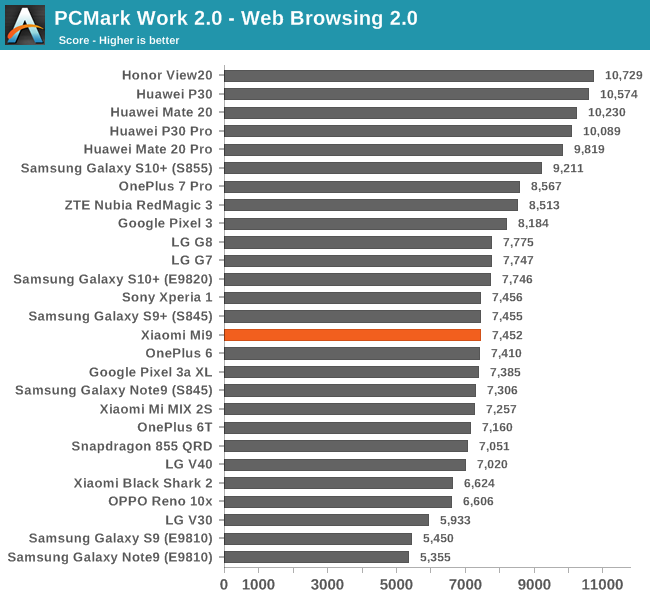
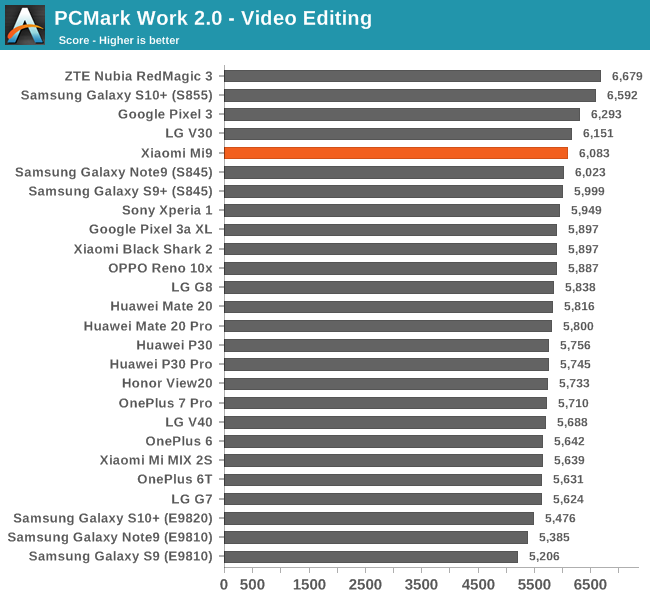
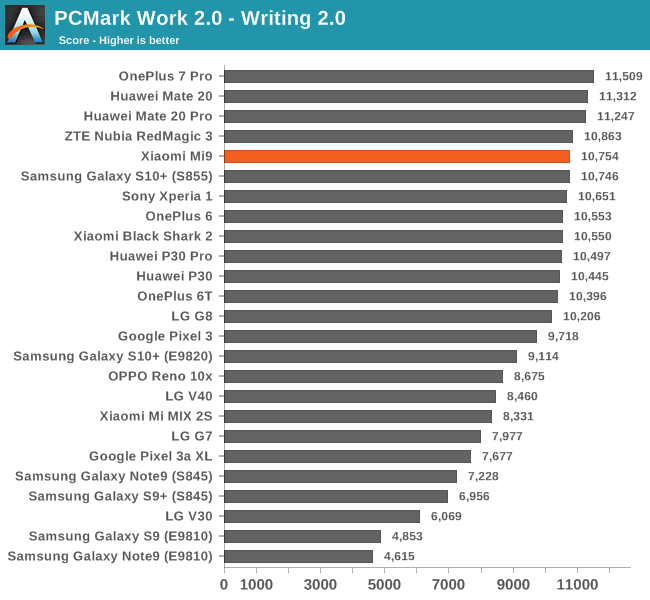
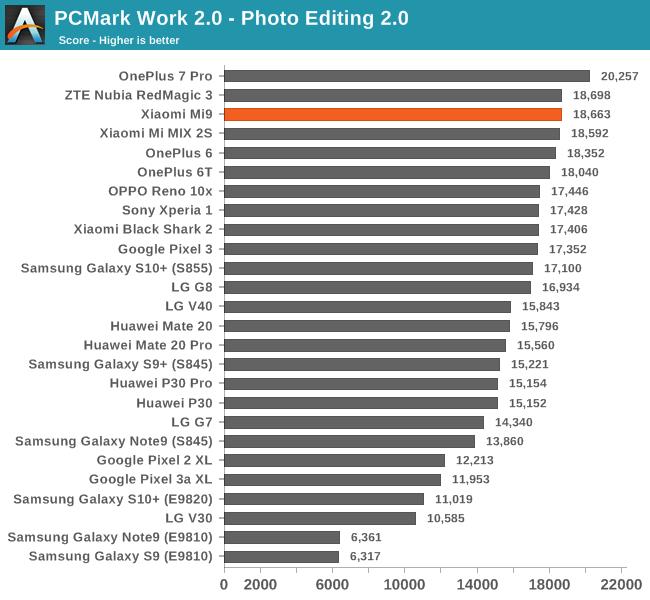
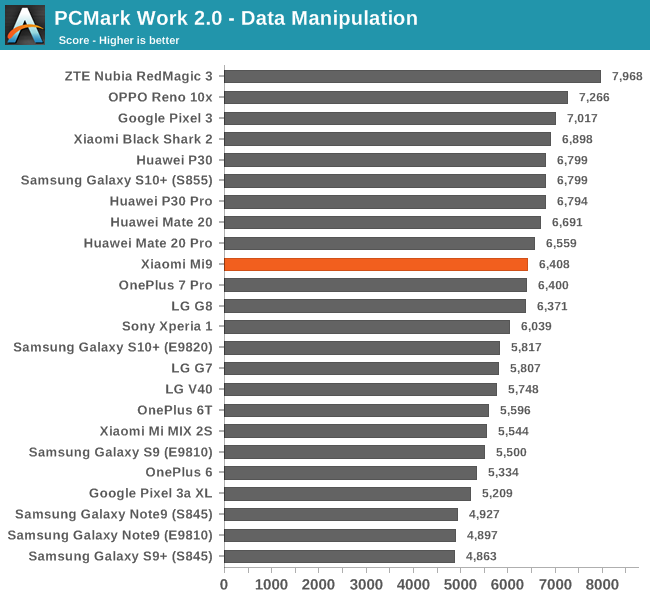
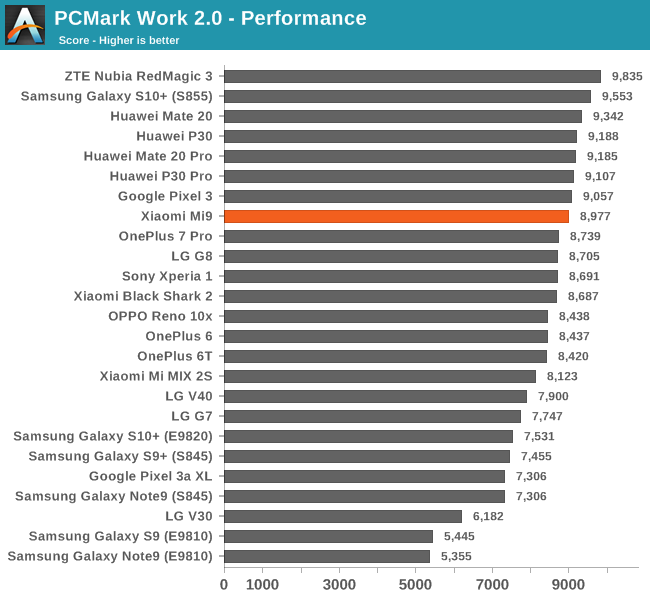
Overall in PCMark, we see the Mi9 also perform averagely but very much within the top tier devices this year. It’s not quite as fast as the Galaxy S10 (S855) or the odd device like the RedMagic 3, but it performs better than say the LG G8.
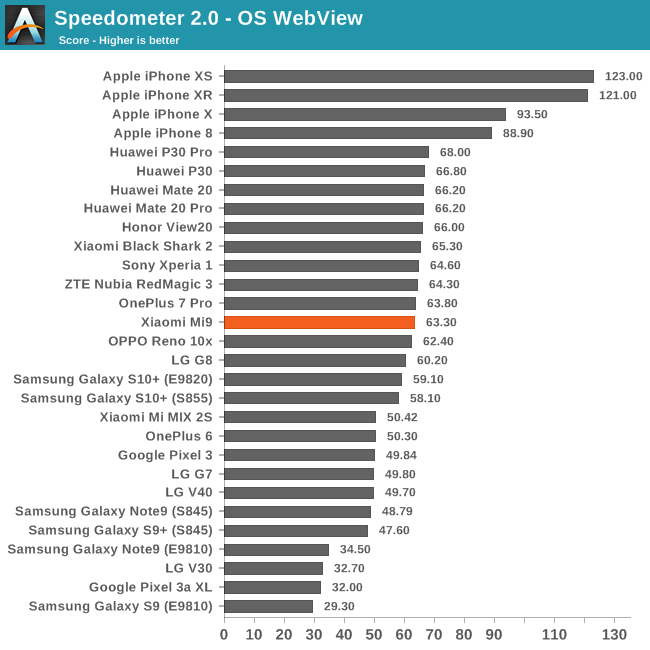
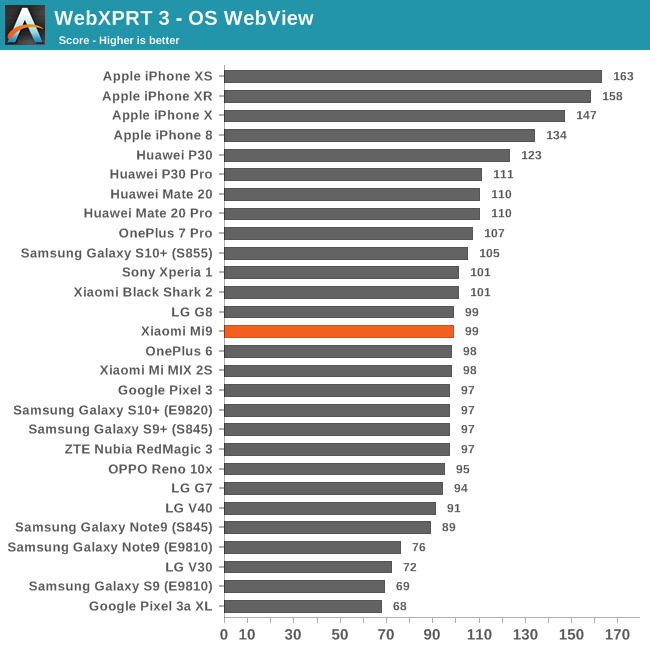
Similarly, to the PCMark results, the Mi9 ends up quite in the middle of the Snapdragon 855 pack in the web browsing JS tests.
Overall, my subjective experience with the Mi9 was excellent. Xiaomi seemingly very well integrated the OS-side boosters and the phone is very responsive when opening or switching between applications. Again I have to mention that while this performance doesn’t really stand out much amongst other flagship devices this year, it’s an incredible showing at the price range that the Mi9 is at. Other mid-range phones in this bracket, such as say the Pixel 3a and similar just can’t really compete with the Mi9.
Machine Learning Inference Performance
AIMark 3
AIMark makes use of various vendor SDKs to implement the benchmarks. This means that the end-results really aren’t a proper apples-to-apples comparison, however it represents an approach that actually will be used by some vendors in their in-house applications or even some rare third-party app.
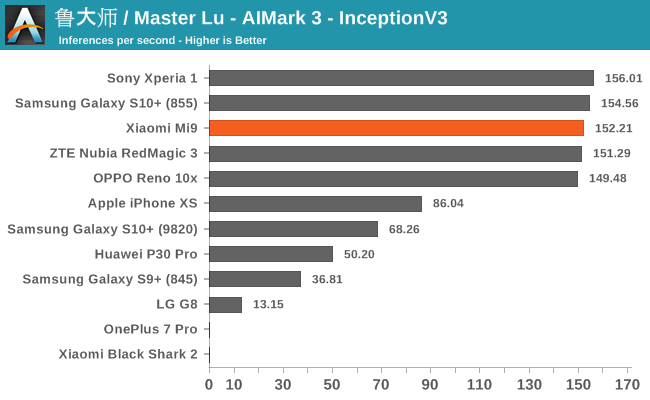
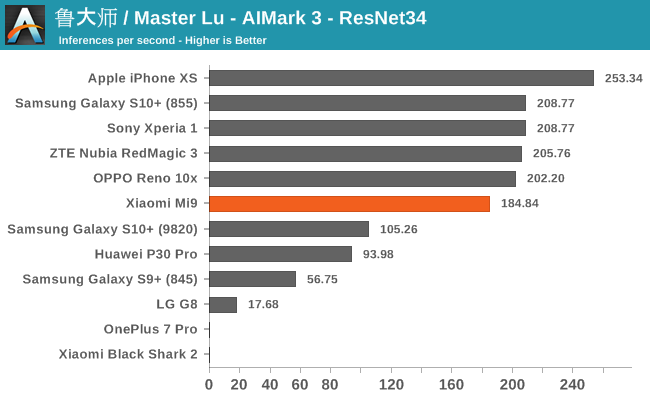
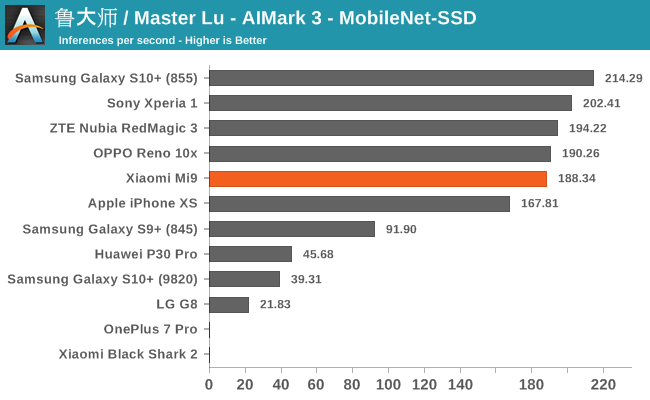
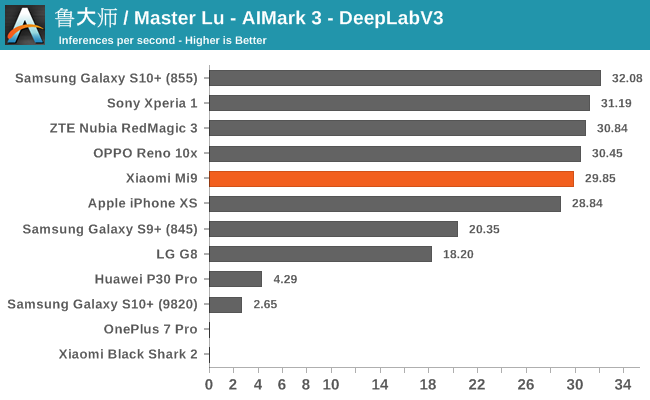
In AIMark, the Mi9 offers the needed library support from Qualcomm for the benchmark to work. In terms of performance, the device ranks high, although it’s just slightly edged out by the rest of the Snapdragon 855 devices.
AIBenchmark 3
AIBenchmark takes a different approach to benchmarking. Here the test uses the hardware agnostic NNAPI in order to accelerate inferencing, meaning it doesn’t use any proprietary aspects of a given hardware except for the drivers that actually enable the abstraction between software and hardware. This approach is more apples-to-apples, but also means that we can’t do cross-platform comparisons, like testing iPhones.
We’re publishing one-shot inference times. The difference here to sustained performance inference times is that these figures have more timing overhead on the part of the software stack from initialising the test to actually executing the computation.
AIBenchmark 3 - NNAPI CPU
We’re segregating the AIBenchmark scores by execution block, starting off with the regular CPU workloads that simply use TensorFlow libraries and do not attempt to run on specialized hardware blocks.
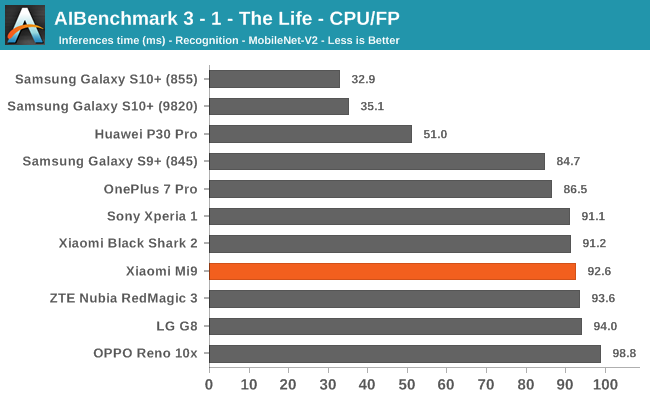
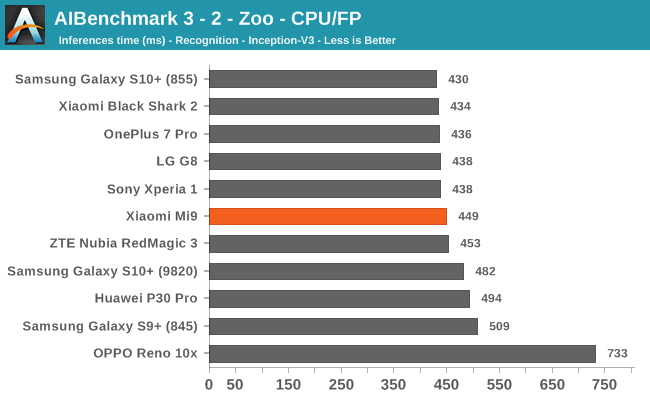
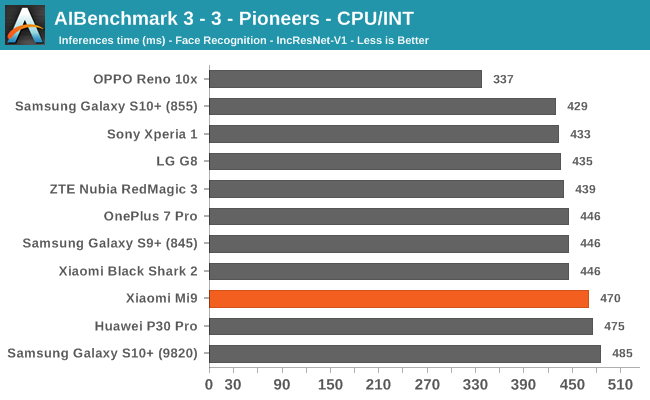
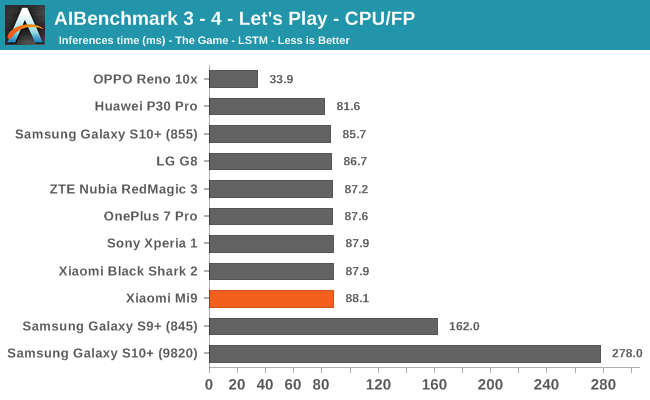
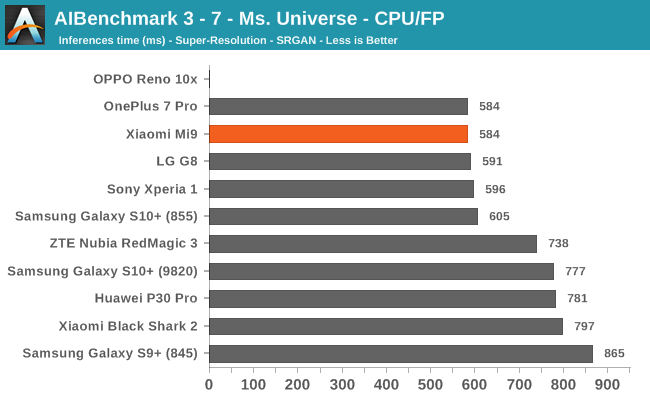
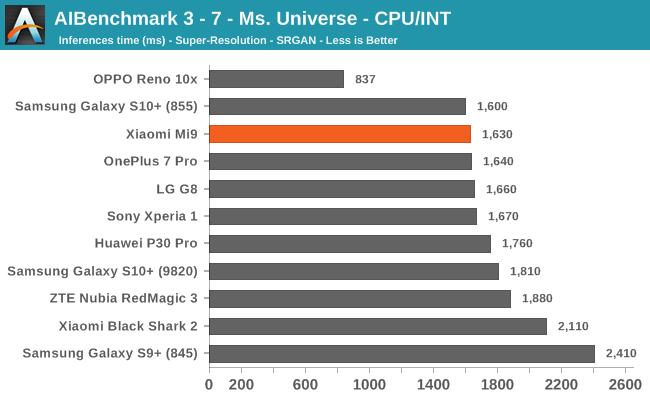
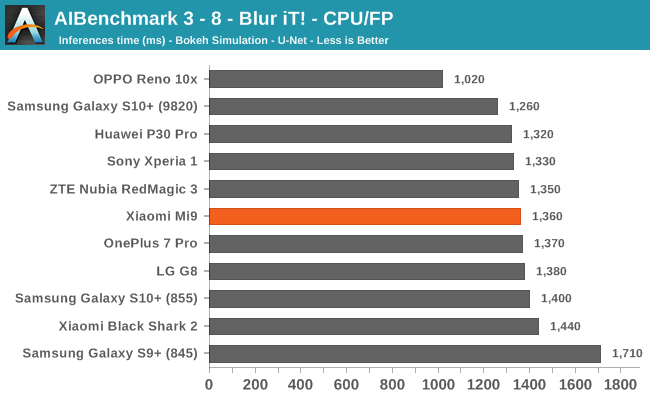
The CPU results in AI Benchmark are relatively mixed in terms of their positioning for the Mi9. In some of them, the Mi9 falls in amongst the last S855 devices, while in others, it more in the middle of the pack. Overall, this is just a matter of how the scheduler and DVFS is tuned on the Mi9. It’s to be noted that the differences between the devices here is very minor, with only a 10% difference between the best and worst Snapdragon 855 devices.
AIBenchmark 3 - NNAPI INT8
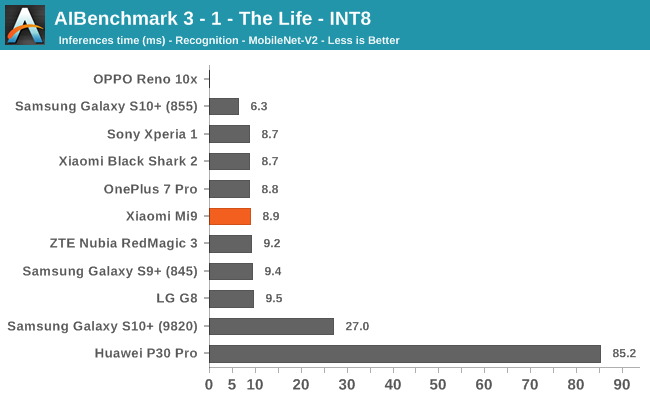
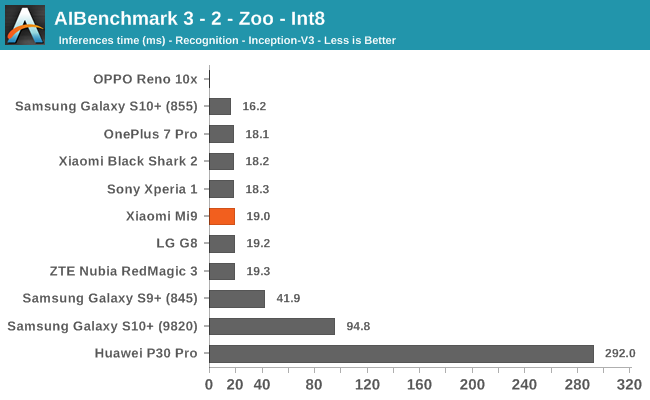
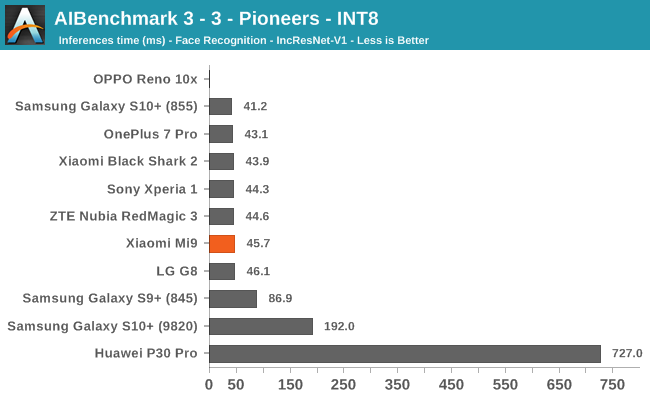
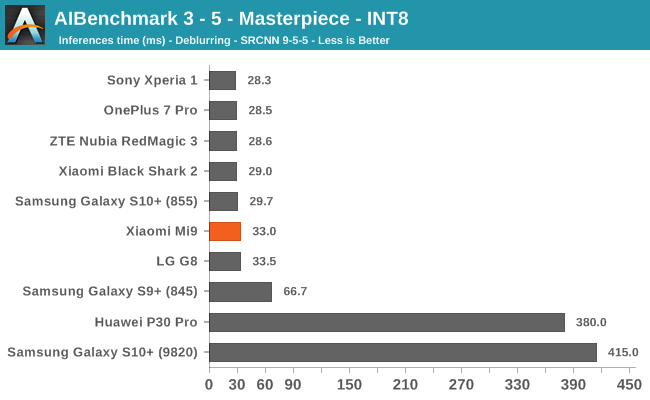
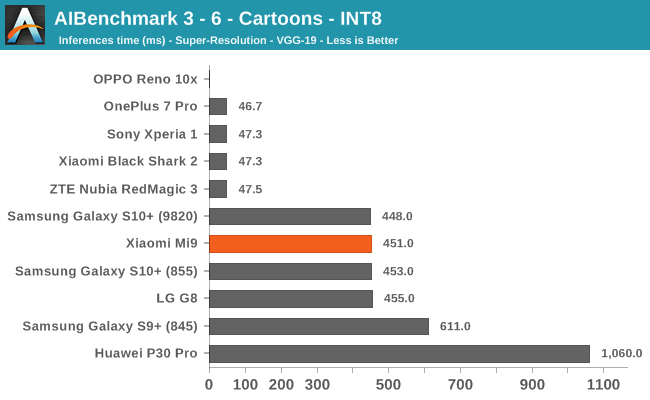
In the INT8 tests which are accelerated on the SoC’s Hexagon DSP, we’re seeing the Mi9 lands in the middle of the pack again.
On the last “Cartoons” test running VGG-19, we’re seeing that the Mi9 is falling behind the rest of the pack alongside the LG G8. The reason for this is likely that the device is shipping with older NNAPI drivers than the rest of the Snapdragon 855 phones. The firmware we’ve tested this on was the latest at the time of testing in early September.
AIBenchmark 3 - NNAPI FP16
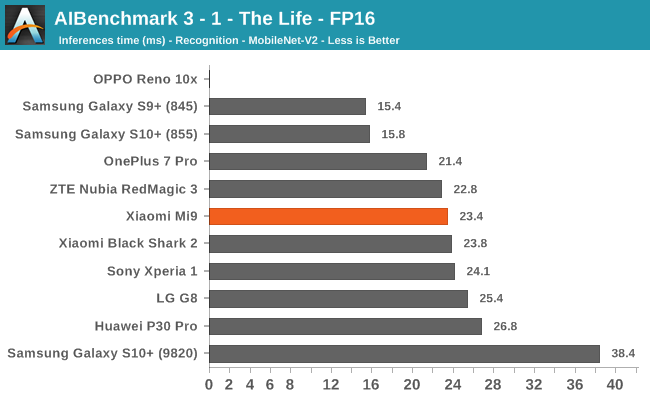
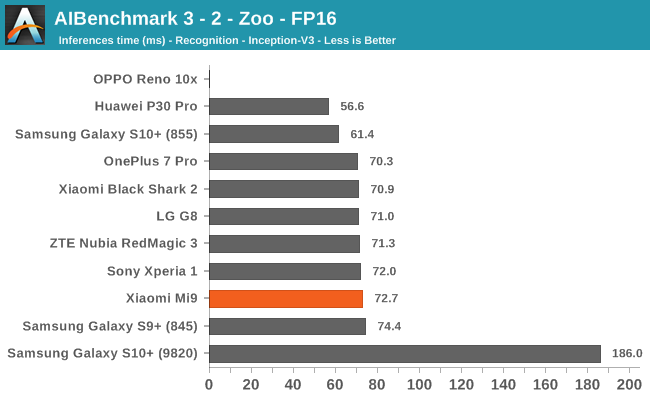
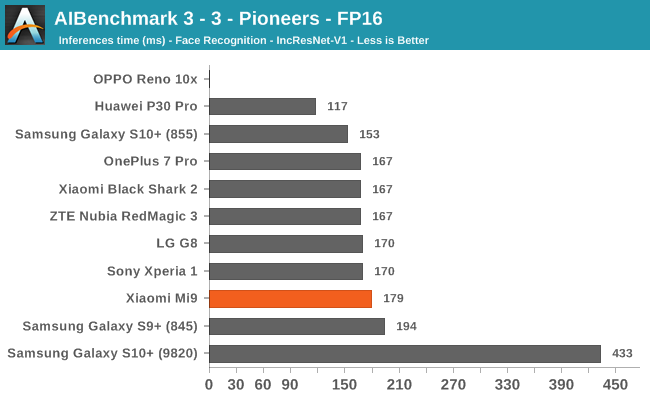
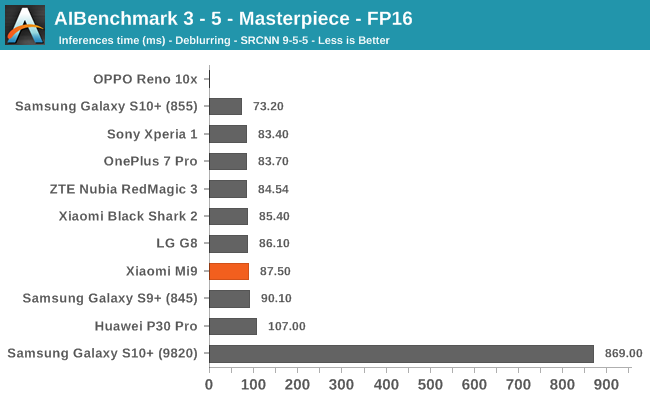
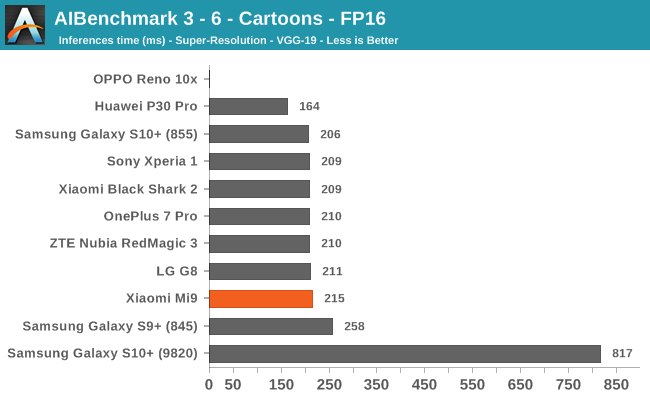
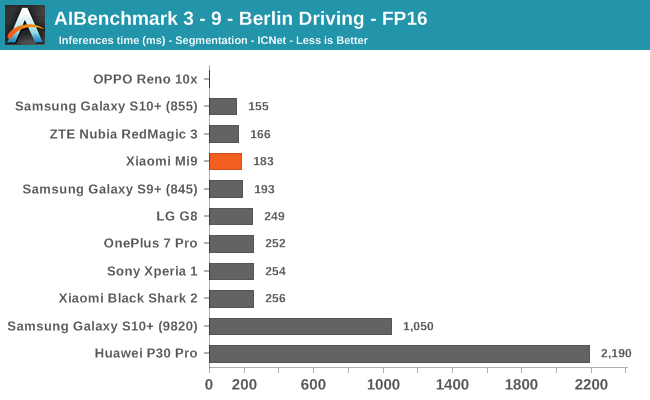
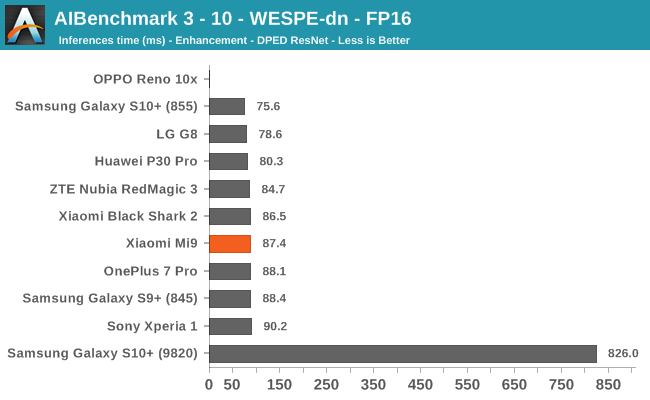
In the FP16 tests the Mi9 again ends up middle of the pack.
AIBenchmark 3 - NNAPI FP32
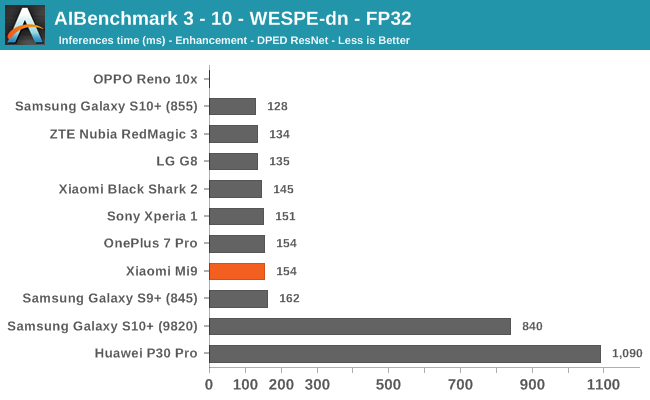
Finally, the FP32 test running on the GPU ends up as the last Snapdragon 855 device in the pack, although again the differences here between the devices are very small, and it’s still performing vastly better than any other non-Snapdragon device.
GPU Performance
GPU performance of the Mi9 will be dictated by how Xiaomi was able to implement the SoC in the physical hardware shell of the phone, and how well it’s able to dissipate the heat throughout the body of the phone. Other factors on the software side such as thermal throttling limits can also greatly impact the results, and as we’ve seen in the S855 we can see very much a wide range of results amongst the many Snapdragon 855 devices.
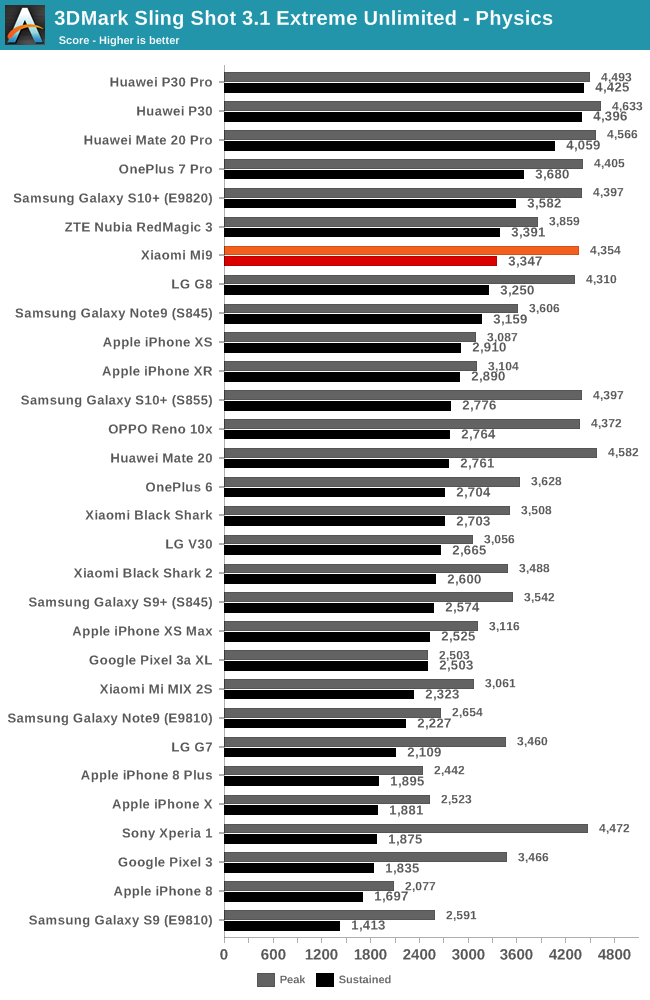
On the 3DMark Physics test which is a CPU stress test within a GPU thermally constrained power scenario, we see the Mi9 perform very well in the sustained long-term results. It’s not quite as good as the OnePlus 7 Pro or the RedMagic 3, but it beats all other Snapdragon 855 devices.
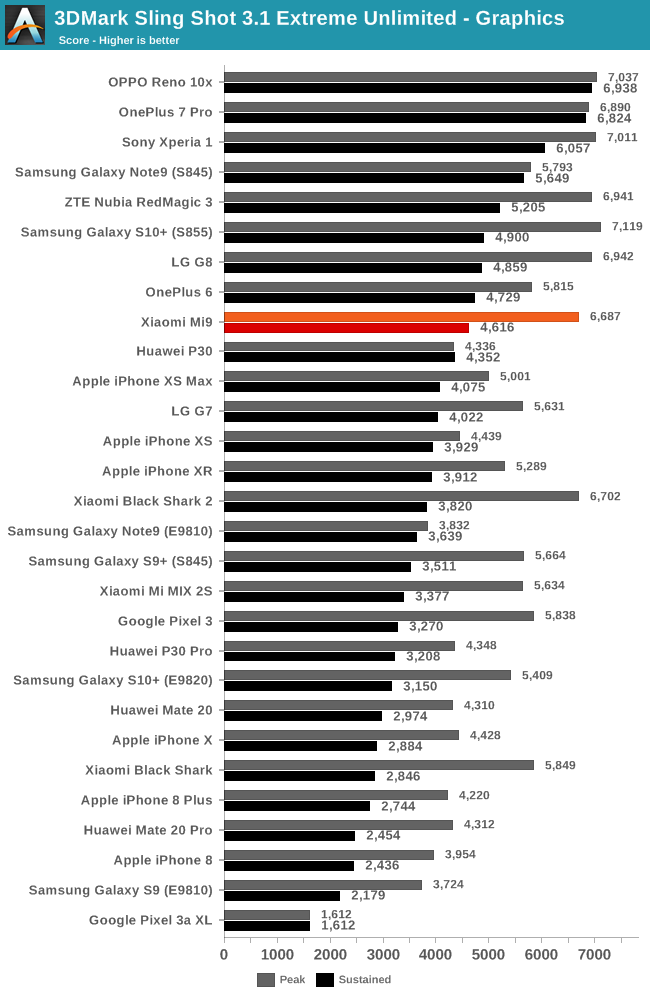
In the graphics test, the positioning shifts a bit amongst the devices, with the Mi9 falling back to the middle of the pack. Still it’s a good performance given that the Mi9 has one of the lower body masses amongst the phones, and thus not quite as good thermal dissipation abilities.
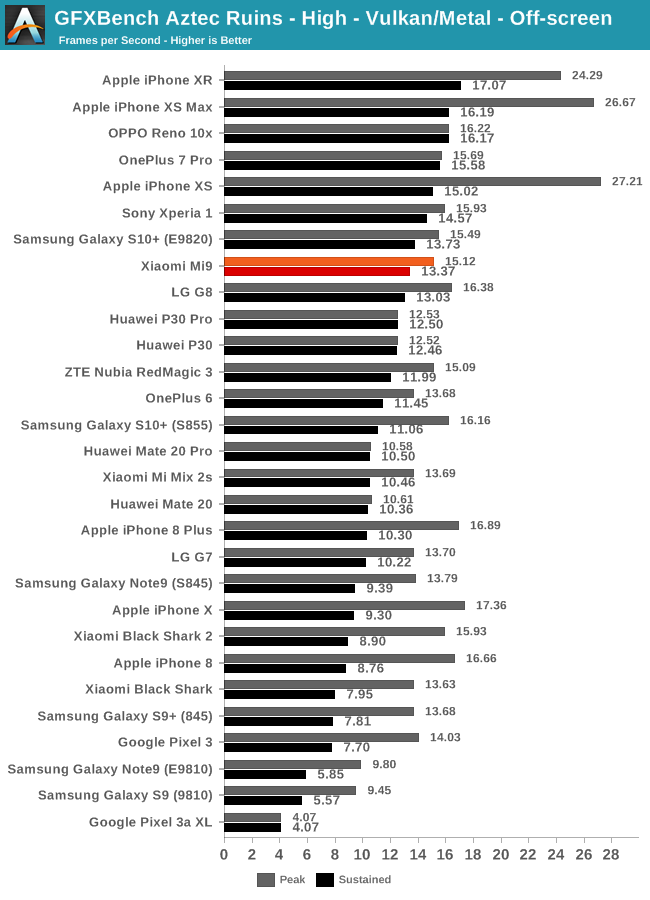
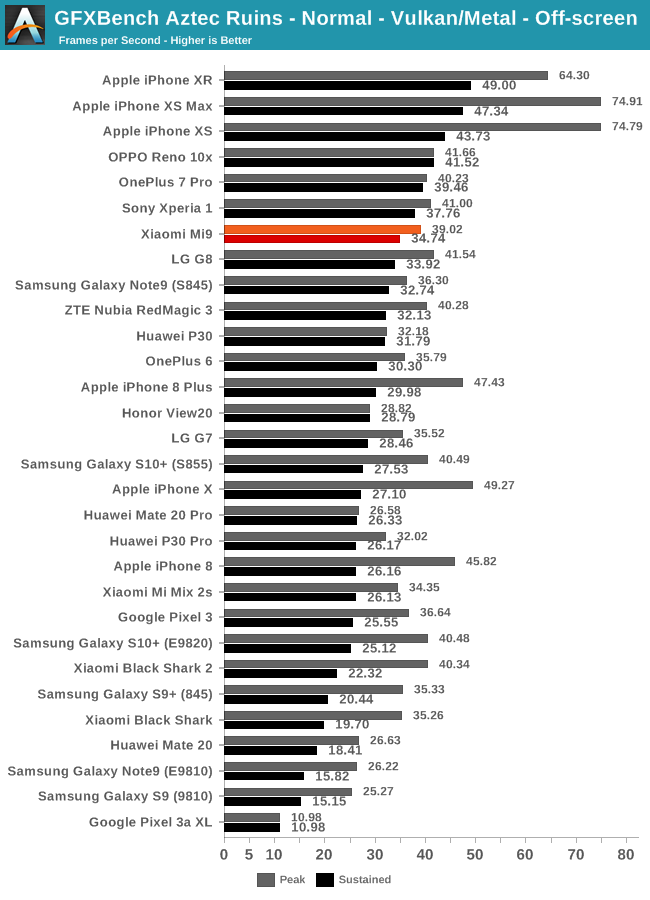
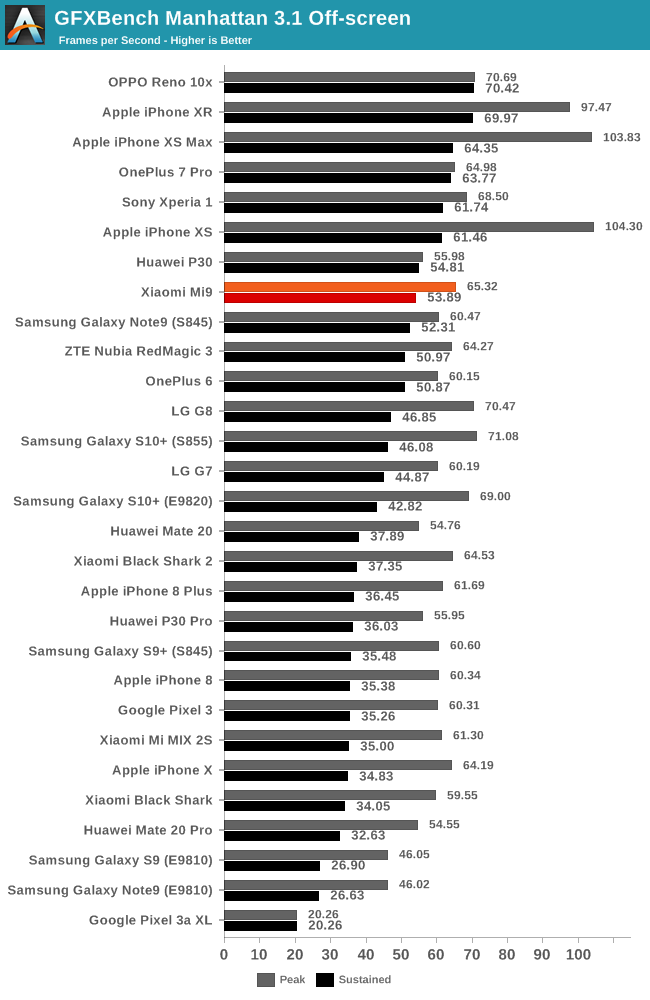
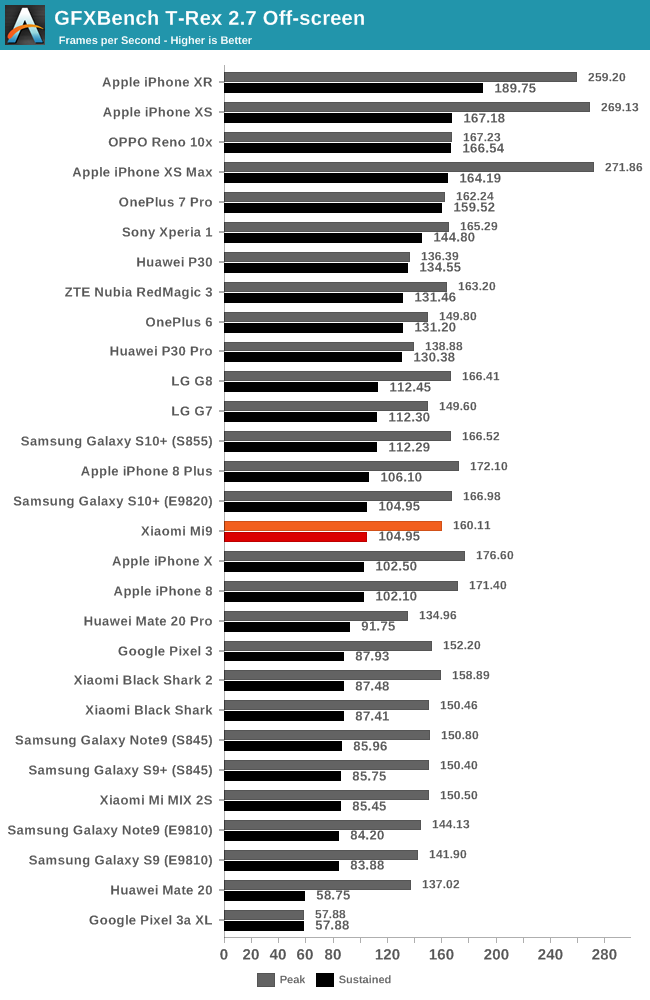
In GFXBench, we’re seeing again some very good results for the GPU performance of the Mi9, however it stands a bit out that the delta is greater in workloads like T-Rex. Here the large framerates put more stress on the CPU as well as memory of the phone, likely creating more heat and in turn forcing the Mi9 to throttle more.
Overall, the Mi9’s gaming performance was very good and competitive. It’s not the best but it’s also far from the worst amongst Snapdragon 855 devices. The odd thing here is that the Mi9 performs significantly better than Xiaomi’s own Black Shark 2 gaming-oriented phone whose sustained performance just completely collapses in our stress tests. We’ll be reviewing the Black Shark 2 separately in the next few weeks, but things aren’t looking well for that phone.
Display Measurement
The Mi9 comes with a 6.39” AMOLED panel sourced from Samsung, and features a 2340 x 1080 resolution.
In terms software settings, Xiaomi offers three screen modes; “Automatic contrast”, “Increased constrast” and “Standard”. Amongst the three, the standard setting is targeting the sRGB colour space, whilst the increased contrast is a non-standard gamut wider than DCI-P3 which looks to be the panel’s native gamut capabilities. Amongst the three colour spaces, Xiaomi also offers colour temperature tuning. I noticed that although the UI greys out the colour temperature settings for the Increased Contrast and Standard modes, the customized settings are actually still applied, even though they can only be adjusted when the Automatic mode is selected. For this review I stayed with the “Default” colour temperature pre-set as it was the best amongst the three pre-sets.
We move on to the display calibration and fundamental display measurements of the Mi9 screen. As always, we thank X-Rite and SpecraCal, as our measurements are performed with an X-Rite i1Pro 2 spectrophotometer, with the exception of black levels which are measured with an i1Display Pro colorimeter. Data is collected and examined using SpectraCal's CalMAN software.
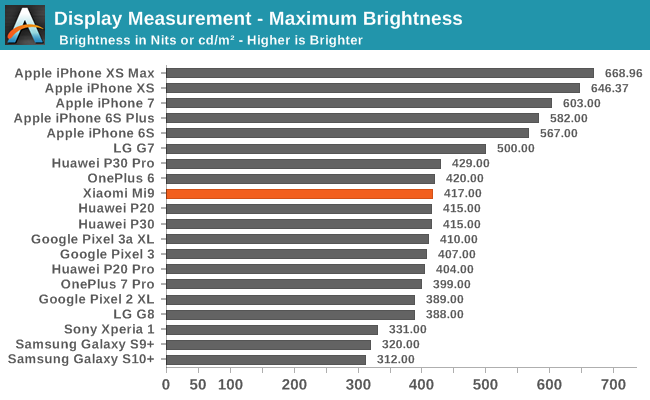
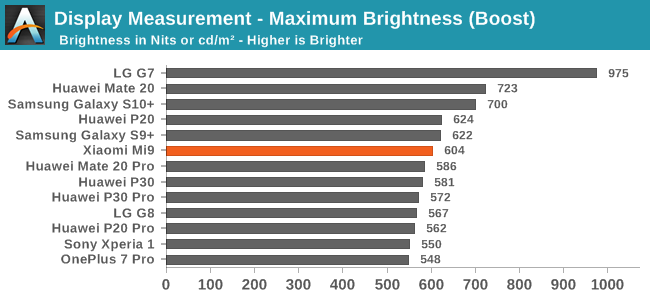
In terms of brightness, the Mi9 is on par with current generation AMOLED devices. At maximum manual brightness, the phone reaches a peak luminosity of 417nits. When in adaptive brightness and under bright environments, the phone goes into a high brightness mode and can reach up to 604 nits on a full screen white.
On the greyscale accuracy test, we’re seeing that the Mi9 is a little bit off in terms of gamma as well as colour temperature. The gamma reaches an average of 2.33 at the 200cd/m² brightness level. We’re measuring this data-point with APL50 and window size of 50%. We notice the gamma figure appears to be more accurate at the maximum brightness measurement set, but that set was performed at APL100, pointing out possible miscalibration of the gamma, something that sadly a very great number of vendors aren’t able to get right.
The colour temperature is also a bit on the warm side, with the reds dominating. This seems to get worse the brighter the panel gets, with white levels at 6463K at 200cd/m² and 6250K at 417cd/m². It’s to be noted that this is something that can be alleviated by the software colour temperature control, however the “Cool” preset is far too cool, and our measurements here are also just unique to the device we have at hand.
Overall, the redish tint might not be too noticeable, however tones will appear slightly darker than they should be due to the higher gamma.
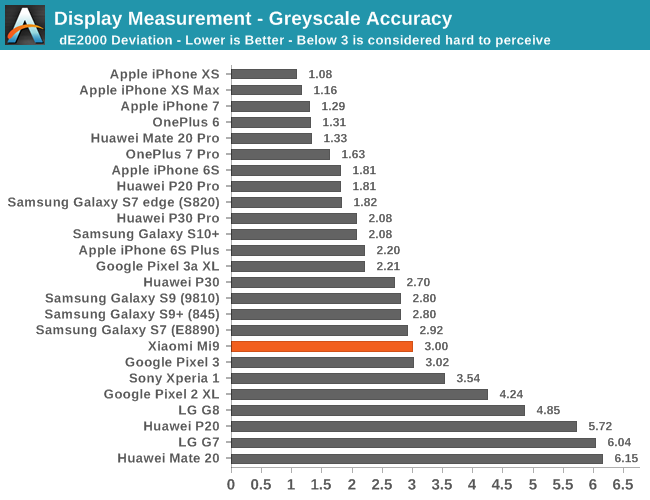
The resulting greyscale accuracy ends up with a DeltaE2000 of 3.00, just at the limit of what should be acceptable.
The standard mode targeting sRGB has relatively accurate saturations and gamut targets. Notice that the increased gamma we measured on the greyscale test here doesn’t appear in the yellow and blue spectrum, albeit present on the mid saturation points of the red channel. Another inaccuracy also seems to be that the blue channel is off hue, causing a larger error also in the magenta colours, besides the whole redshifted gamut.
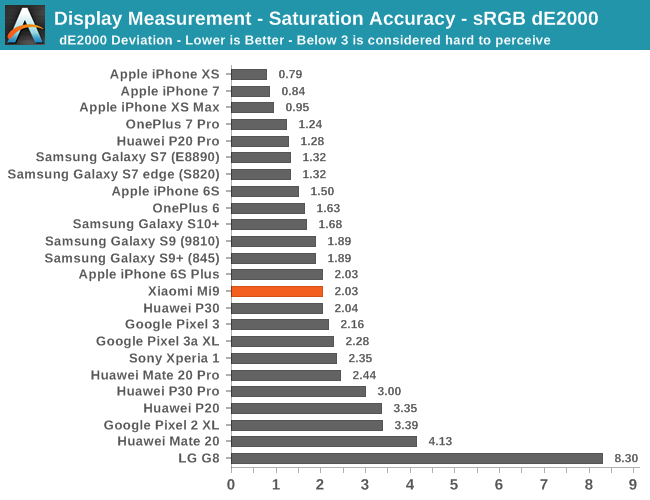
Still, with a deltaE2000 of 2.03, the results are quite ok and we’ve certainly seen worse from other devices.
I wanted to also showcase the saturations of the “Increased contrast” mode. The above graph targets the DCI-P3 gamut at gamma of 2.2 (Display P3), yet we clearly see that this mode’s gamut goes beyond the aforementioned standard. It doesn’t really adhere to any particular standard, and simply seems to be the OLED panel’s native large gamut with popping colours.
Finally, in the Gretag-Macbeth chart of commonly found tones and skin colours we see the results of the phone’s slightly too high gamma as well as the overall red-shifted colours.
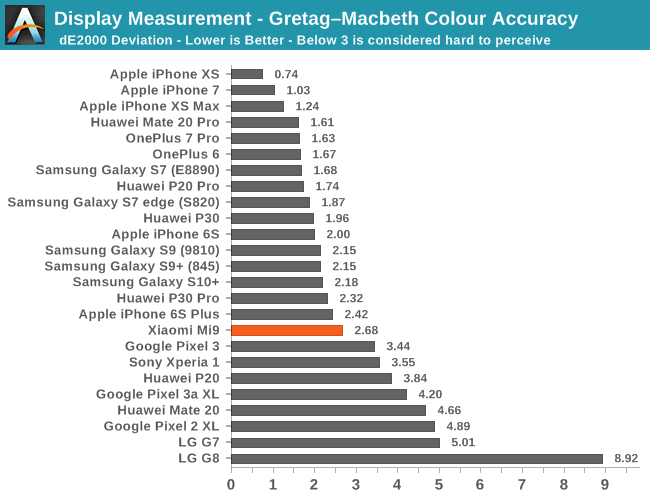
Overall, the phone still managed to achieve a passable dE2000 of 2.68, which is not great, not terrible.
Overall, the Mi9’s screen is in my opinion a good screen. Contrast, brightness and viewing angles are again as usual of an OLED screen very good and the Mi9 doesn’t disappoint in this regard. In terms of colour calibration, the Mi9 did ok, we’ve certainly seen better calibrated devices out there but the Mi9 is also not outright bad. For users looking for the best accuracy I recommend the standard mode and trying to slightly adjust the colour temperature to their liking if they so happen to notice the slight red shift that appeared on our review device.
Battery Life
Battery life of a device is dictated by the SoC efficiency, screen efficiency and battery capacity. The Mi9 has an efficient SoC, and it should have an adequately efficient screen, however its battery capacity of 3300mAh is on the lower side compared to competitor devices this year, which are found to sport 3700-4000+ mAh units.
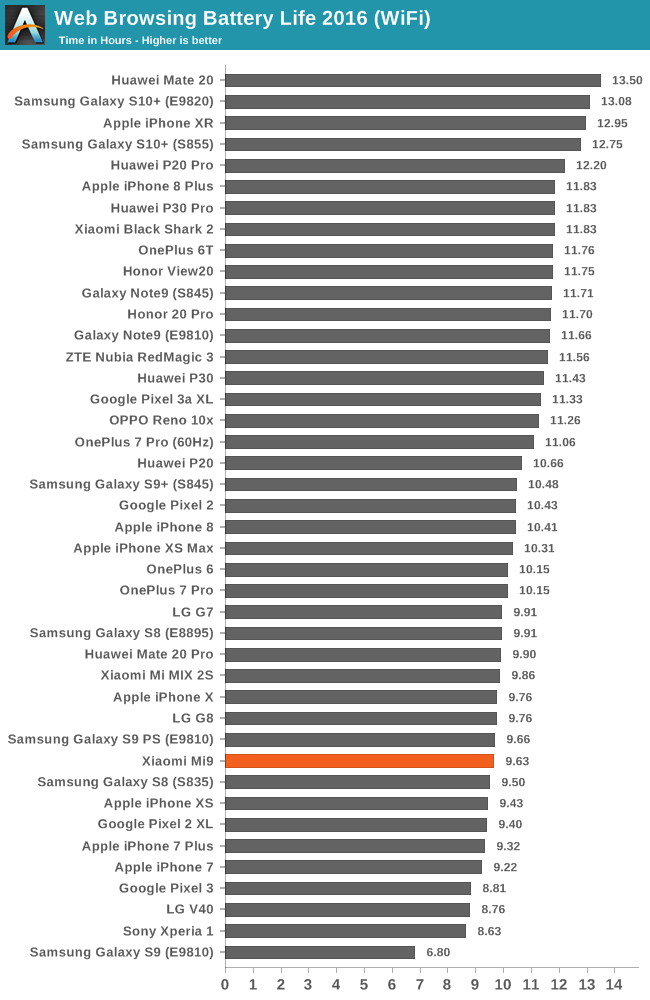
In the web-browsing test, the Mi9 ends up as expected on the lower half of our device database of recent flagships. The phone lands near where the G8 landed.
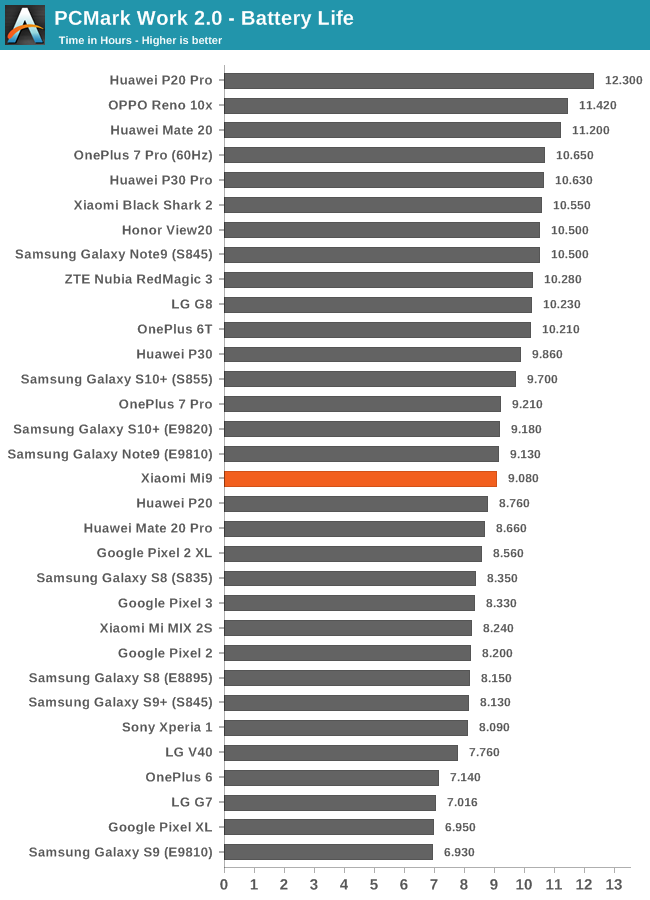
Similarly, in PCMark, the Mi9 ends up quite average in terms of its longevity. It’s not bad at all, but still remains as the lowest longevity of S855 devices, just a hair worse than the 90Hz mode of the OnePlus 7 Pro.
Overall while the Mi9 certainly doesn’t compete in battery to the likes of the Galaxy S10+, it should offer sufficient longevity to get most users through the day.
Camera - Daylight Evaluation
The Mi9’s camera setup is certainly a key factor for the device. The combination of a triple camera setup at this price range is very uncommon, and Xiaomi historically has had quite good post-processing calibration. It’s also a new vendor amongst the many IMX586 6 implementations we’ve seen this year, giving us another look at how post-processing can differ results of the same hardware.

[ Mi9 ] - [ S10+ (E) ] - [ S10+ (S) ]
[ Xperia 1 ] - [ P30 Pro ] - [ Reno 10x ]
[ G8 ] - [ BlackShark 2 ] - [ RedMagic 3 ]
[ Pixel 3 ] - [ iPhone XS ]
In the first shot we see the Mi9 do very well in terms of the exposure. For this comparison I didn’t quite have all the IMX586 phones included, however I think this was probably the best showing of all the devices out there. Xiaomi’s processing still managed to accurately capture the lighting of the scene all without unnaturally darkening shadows or eating up the highlights.
Particularly the colour balance was spot on, another thing I noticed many phones have issues with in this scene. The Mi9 even populates the EXIF of the shot with the correct D55 WB illuminant.
In terms of detail, the Mi9 doesn’t stand out too much, but this was again expected of the camera sensor whose quad-bayer sensor design doesn’t seem to be able to have as quite good spatial resolution and pixel deep trench isolation as classical native bayer sensors.
The wide-angle shot also does very well in terms of exposure and colour-balance. Detail is also relatively strong compared to other wide-angle cameras, but clearly loses to the P30 Pro or Xperia 1. Also note that the wide angle is noticeably narrower than that of the S10 for example.
The telephoto shot is very good again in terms of composition and I don’t have much negative to say about it.
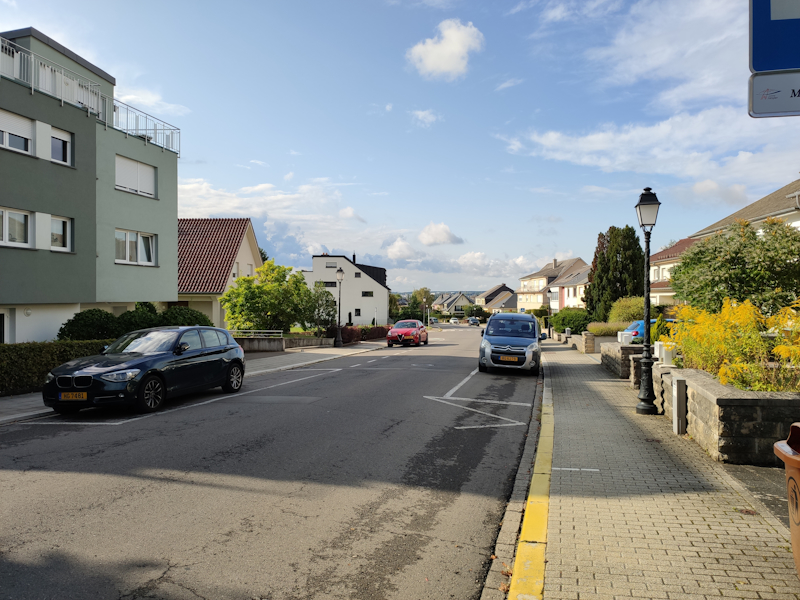
[ Mi9 ] - [ S10+ (E) ] - [ S10+ (S) ]
[ Xperia 1 ] - [ P30 Pro ] - [ Reno 10x ]
[ G8 ] - [ BlackShark 2 ] - [ RedMagic 3 ]
[ Pixel 3 ] - [ iPhone XS ]
In this shot, I think the Mi9’s colour temperature is just a tad too warm, but not too overly off. What’s noticeable here is that the capture is lacking a bit in dynamic range, for example crushing the shadows on the left car far too much, although I can’t say the Reno 10x with the same sensor does any better. Detail-wise, the Mi9 does very well here, avoiding any noticeable noise reduction or sharpening filters.
The wide angle again had a bit too warm colour temperature and this time around I’d also say the exposure is lacking in highlights, avoiding much in the top 10% of levels which results in a bit flatter image. Details for a wide-angle are very good.
The zoom is showcasing similar behaviour, a bit off colour temperature and lacking a bit in the brighter highlights of the scene.

[ Mi9 ] - [ S10+ (E) ] - [ S10+ (S) ]
[ Xperia 1 ] - [ P30 Pro ]
[ Reno 10x ] - [ G8 ] - [ BlackShark 2 ]
[ RedMagic 3 ] - [ Pixel 3 ]
When under cloud cover, the Mi9 seems to also do well in terms of exposure although in this particular scene the flowers look overexposed. The main sensor’s limitations here seem to be solely related to its hardware capabilities, notably lacking behind in sheer dynamic range to be able to capture the petals correctly.
The wide-angle shot is excellent and amongst the best. The reduced viewing angle with the 16MP sensor resolution means the Mi9 gets amongst the most detailed shots among the wide-angle crew. It showcases what the G8 could have been if it didn’t have a post-processing smear filter.
The telephoto here lacks a bit in dynamic range and thus blows out the details of the petals of the flowers.

[ Mi9 ] - [ S10+ (E) ] - [ S10+ (S) ]
[ Xperia 1 ] - [ P30 Pro ]
[ Reno 10x ] - [ G8 ] - [ BlackShark 2 ]
[ RedMagic 3 ] - [ Pixel 3 ] [ iPhone XS ]
The next scene was locally overcast, however still showcasing a bright sky in the background. This confused the processing on the Mi9 a bit as the shots between the main and wide-angle weren’t consistent in terms of their exposure, with the wide-angle being far too dark.
The fine power lines against the bright sky also serve as good subjects showcasing some of the HDR/sharpening drawbacks – we see some odd step-wise artefacts on the Mi9’s towards the centre-left lines, with generally some more noticeable brightness halos around the lines. The latter are also extremely pronounced on the Snapdragon S10 so it’s not something unique to the Mi9.
Because of the exposure issue, the wide-angle isn’t very usable in my opinion. The zoom camera is extremely competitive and I can’t see immediate flaws.
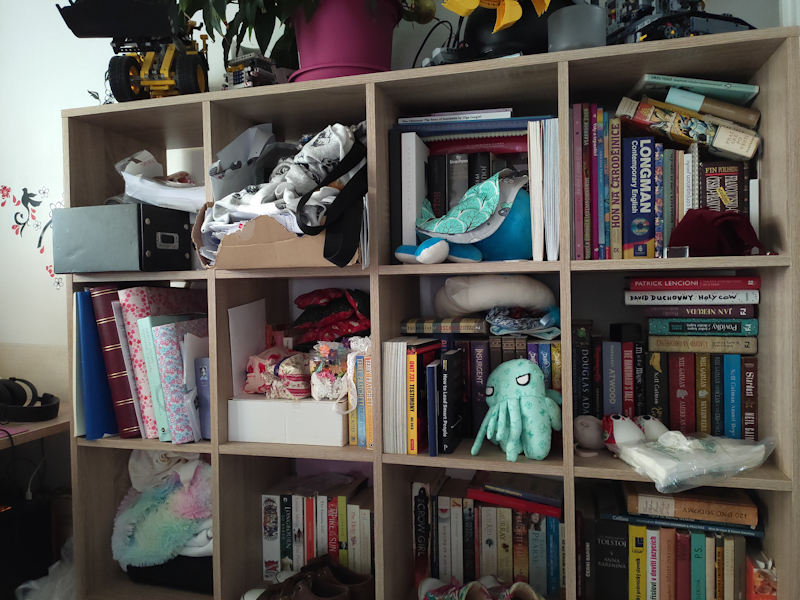
[ Mi9 ] - [ S10+ (E) ] - [ S10+ (S) ] - [ Xperia 1 ] - [ P30 Pro ]
[ Reno 10x ] - [ G8 ] - [ BlackShark 2 ] - [ RedMagic 3 ]
[ Pixel 3 ] - [ iPhone XS ]
Indoors, the Mi9’s main camera sensor is good, but we’re again seeing some hardware limitation of the IMX586 we’ve seen in numerous other phones, such as the reduced dynamic with less details in shadows.
Daylight Camera Conclusion
Overall, I found the cameras on the Mi9 to be very good and also quite competitive. I think this may be the best implementation of the IMX586 in terms of daylight capture results, with Xiaomi traditionally having good calibration resulting in balanced HDR and good colour temperatures. Things weren’t always perfect and there’s shots here and there which were a bit off the mark, but it’s nothing too bad. I think overall, it’s a better main sensor camera experience than the OnePlus 7, both phones being otherwise equal in hardware.
The wide-angle on the Mi9 also was excellent and is above-average in this category. Xiaomi avoids any obvious degrading post-processing and the 16MP thus shines in terms of detail. It wasn’t quite the best in terms of exposure as sometimes it wasn’t consistent with the results that the main camera produced.
Finally, the telephoto was also very good and competitive with good amount of detail, actually achieving some of the best results amongst the 2x optical modules out there. I didn’t see anything particularly wrong here for the Mi9 so it’s a definite positive result.
Overall Xiaomi did a good job on the cameras of the Mi9 – at least in the context of what the sensors are able to achieve.
Camera - Low Light Evaluation
The Mi9’s expectations for low-light photography shouldn’t be too high: The IMX586 wasn’t a fantastic performer in any phone until now, but on the Mi9 it’s exasperated by the fact that the phone lacks OIS, a critical missing component to be able to get sharper low-light shots. Here’s to hope that the Mi9 at least managed to do adequately compared to the competition:

[ Mi9 ] - [ S10+ (E) ] - [ S10+ (S) ]
[ Xperia 1 ] - [ P30 Pro ] - [ Reno 10x ]
[ G8 ] - [ BlackShark 2 ] - [ RedMagic 3 ] - [ Pixel 3 ]
As expected, things aren’t off to be a very good start here. Comparing the Mi9 to the Reno 10x with the same hardware, we’re seeing relatively similar compositions between the two phones. The difference here is that the Reno is able to capture an exposure twice as long at half the ISO level of the Mi9, which has to go up to ISO7066 in this scene. The Reno still managed to end up with a vastly sharper image, all in likelihood thanks to the OIS it employs.
Thankfully, the Mi9 does have a computational photography night mode. The mode does help the phone a lot in terms of exposure, however it just can’t too much in terms of enhancing details and lacks behind the night modes of other phones.
The wide-angle doesn’t have the option to use the night mode, and thus ends up quite disappointing and uncompetitive.
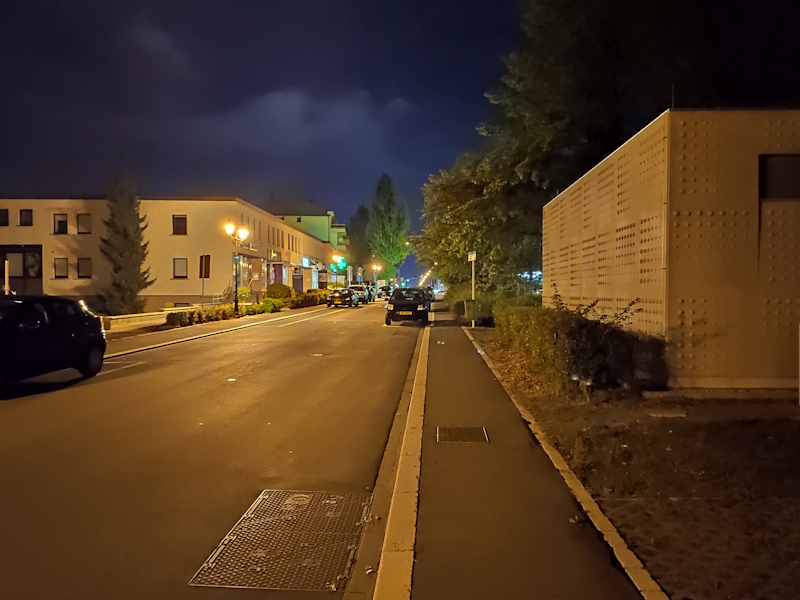
[ Mi9 ] - [ S10+ (E) ] - [ S10+ (S) ]
[ Xperia 1 ] - [ P30 Pro ] - [ Reno 10x ]
[ G8 ] - [ BlackShark 2 ] - [ RedMagic 3 ] - [ Pixel 3 ]
The next shot unfortunately ends with similar results. Without night mode, the Mi9’s capture is just disastrous and reminded us of devices 3+ years old, maybe even worse. Night mode makes things passable and useable, however if we compare the night mode of the Mi9 against the automatic night mode shot of the Reno 10x, the results are just incomparable.
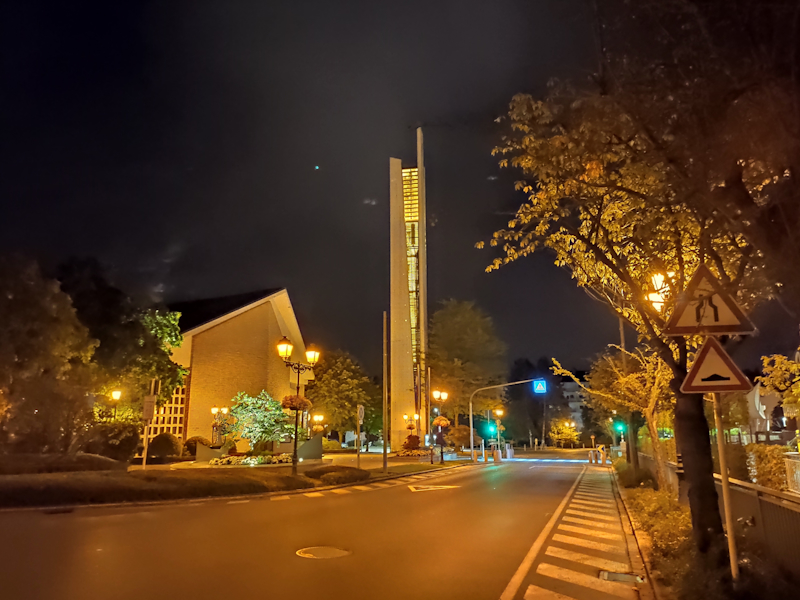
[ Mi9 ] - [ S10+ (E) ] - [ S10+ (S) ]
[ Xperia 1 ] - [ P30 Pro ] - [ Reno 10x ]
[ G8 ] - [ BlackShark 2 ] - [ RedMagic 3 ] - [ Pixel 3 ]
Same with the next shot, night mode makes the exposure passable, but it’s just lacking in any kind of detail.

[ Mi9 ] - [ S10+ (E) ] - [ S10+ (S) ]
[ Xperia 1 ] - [ P30 Pro ] - [ Reno 10x ]
[ G8 ] - [ BlackShark 2 ] - [ RedMagic 3 ] - [ Pixel 3 ]
Extreme low-light becomes a blur.

[ Mi9 ] - [ S10+ (E) ] - [ S10+ (S) ]
[ Xperia 1 ] - [ P30 Pro ] - [ Reno 10x ]
[ G8 ] - [ BlackShark 2 ] - [ RedMagic 3 ] - [ Pixel 3 ]
Indoor dim lighting actually ends up better with Night Mode off for the Mi9 as at least it’s able to resolve some detail, with the mode on it becomes another unusable blur.
Low-light Conclusion - Terrible
Overall, Xiaomi’s choice of not employing OIS on the Mi9 is very costly in terms of the low-light photography results. The phone just isn’t competitive in any kind of scenario and the results are quite most terrible. Don’t expect to be able to do much at all after the sun sets.
Conclusion & End Remarks
The Xiaomi Mi9 was one of the missing flagship phones that was eager to cover this year but hadn’t had the chance to till now. Overall, I’m glad to have been able to test the device even though it’s later in the year, and it did reveal it’s still quite the good overall package and offers excellent value.
Design-wise, I actually do love the Mi9 simply because of its ergonomics that I find impeccable and extremely comfortable. Even though the phone’s screen is among the larger diameters at 6.39”, it very much feels like a smaller phone thanks to its very thin side-frame. The device is also relatively light for its size, comparable with what Samsung is able to offer in terms of size-weight ratio.
The display is very good and on par of what you’d expect of an AMOLED screen, offering excellent contrast and Xiaomi allows the panel to also get plenty bright. Colour calibration is also quite acceptable, being not great, but terrible. It should very much satisfy the vast majority of users.
Performance of the Mi9 is excellent thanks to the Snapdragon 855 SoC the company chose to employ in the phone. CPU and GPU performance that the phone is able to deliver is just beyond anything else that’s currently available in its price class, very much a Xiaomi tradition.
Battery life of the Mi9 is relatively average – the comparatively smaller 3300mAh battery capacity of the phone loses out to other devices which are in the 4000mAh class. On the other hand, Xiaomi also offers wireless charging in the Mi9, which is a bonus for quickly topping off every now and then, and the phone package bundles in an 18W charger.
In terms of cameras, the Xiaomi Mi9 surely offers a good amount versatility thanks to its triple-camera setup.
I found Xiaomi’s post-processing to be among one of the better ones out there, producing some of the best results out of the IMX586 sensor amongst the countless vendors and devices out there with the similar hardware setup. The wide-angle and zoom modules were also extremely competitive in daylight, producing sharp photos with competitive compositions.
Unfortunately, where the cameras completely fall apart in the Mi9 is low-light photography and video. The lack of OIS on even the main sensor of the phone is deadly, and the cameras just aren’t able to produce useable results. Xiaomi offers a Night Mode to help along with things and it does improve the situation, however the phone still remains plainly uncompetitive in terms of picture quality.
Other compromises of the Mi9 is in the audio department, although with a similar earpiece speaker setup as the OnePlus 7, the Mi9 lacks stereo playback and just has to rely on the bottom speaker.
Xiaomi is able to offer the Mi9 at such a low price thanks to some partnerships and advertising, in this case MIUI here and there can show ads, particularly in the post-installation screens of applications. Personally, I couldn’t care less about these ads as the rest of the UI experience was seamless – but potential buyers should be aware of them.
Overall, I think the Xiaomi Mi9 is a fantastic device with the only real and possible deal-breaking compromise being its low-light photography. I hope for the next generation Xiaomi doesn’t make this compromise again, even if the phone costs 10$/€ more.
At 400€ the phone still offers incredible value, and I think any potential buyer will be happy with their purchase.

